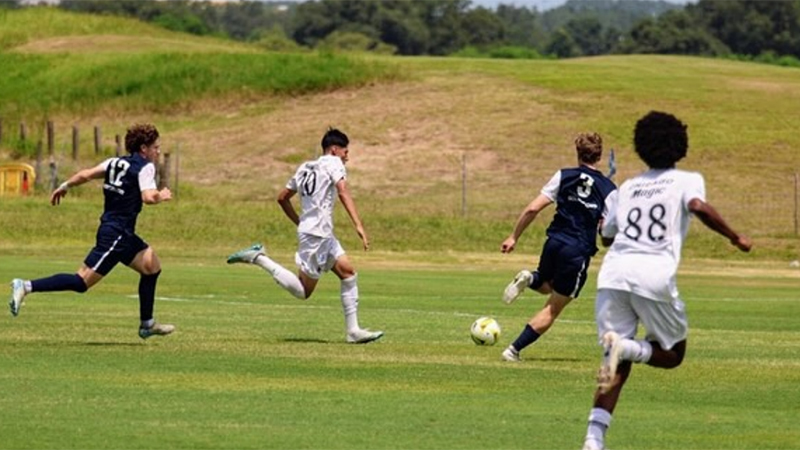U.S. beats Italy...Worth Shouting about?
March 2, 2012
In the aftermath of the United States’ victory in Genoa, the New York Times hailed, “A U.S. Win Worth Shouting About.” While this may be true, it may be worth considering just what it is we should be shouting for.
The narrative surrounding the U.S.’s first win over the Italians has been delivered to the tune of 11 attempts in 82 years, and finally, yes finally, we’ve defeated the mighty Azzuri. Match commentator Ian Darke, anchoring ESPN2’s coverage, struck the initial chords expressing utter amazement after Clint Dempsey’s go ahead goal, and America’s dogged defense that held Italy scoreless for the remaining thirty minutes of play. “Well this is rather unbelievable,” Darke effused, “one of the greatest victories in America’s history.” Fine I suppose, but perhaps a bit naïve in the same breath. To get beyond the naïveté, let’s consider the two categories in their own right; the U.S.’s victory, and our soccer history.
First, a look at our soccer history. Have we ever beaten the Italians? No. Would it be worth listing off all the teams we have or haven’t beaten, elite or otherwise, to come to grips with what this means? This would be a waste of time if you ask me, for two reasons.
First, as soccer nations go, we remain very young when compared to the likes of Italy, Germany, Brazil and Argentina. While U.S. soccer historians will always herald an unlikely victory over England in the 1950 World Cup as a unique national achievement, we would be foolish to suggest that our nation's soccer history reaches back that far using any objective criteria. In reality, the true dawning of our nation’s soccer history begins at the 1990 World Cup, where a bunch of College All Americans traveled to Italy to play seasoned professionals of the greatest clubs in the world: clubs I might add that our player’s have only recently been considered as worthy members.
Fast forward to February of 2012 and our soccer history spans a twenty-two year blink of an eye. For those desirous of instant gratification, twenty-two years may seem like an eon. For the Germans, who’ve competed in every World Cup since it’s inception, or the Spanish who’ve just won their first World Cup after thirteen attempts, it’s hard to take a twenty-two year span too seriously. So while a victory over Italy adds to our collective soccer consciousness, it seems a bit over stated to pop champagne when in our twenty-two year span we’ve competed in six World Cups, reached the knock out stages in three of them, while gaining precipitous international respect with each passing year. When a nation is a perennial participant in the World Cup, reaching the final sixteen in half of its appearances, they’re hardly a squad to shrug off. Just ask the Czech Republic, Colombia, Nigeria, Ireland, or The Ivory Coast if they’d prefer to switch places. I suspect they would.
Second, with respect to the match itself, that the U.S. scored an opportunistic Clint Dempsey goal, largely against the run of play in a 1-0 victory over a strong Italian side should come as no surprise. To gain an additional layer of perspective, let’s press rewind on our twenty-two year soccer history, and for a moment remember that if it weren’t for Paul Caliugiri’s miraculous long range strike – on a field akin to a cow pasture surrounded by a soccer stadium – against Trinidad and Tobago, the United States does not qualify for the 1990 World Cup. On the wings of Caliugiri’s under appreciated, yet legendary goal, transition from lowly CONCACAF qualification to the Olympic Stadium in Rome, a squad that included Steve Trittschuh (Tampa Bay Rowdies), Jimmy Banks (Milwaukee Wave), Brian Bliss (Albany Capitals) and Desmond Armstrong (Baltimore Blast), faced the likes of Gianluca Vialli (Sampdoria, and later player/manager of Chelsea), Roberto Baggio (Fiorentina, eventual World Player of the Year), Paolo Maldini (A.C. Milan, and arguably the greatest left back of all time). If, on the night of June 14 a motley crew of Yanks, mostly representing indoor soccer teams of what was then AISA, had managed to do anything more than concede the one goal they did, it would have been cause for celebration. Had they tied or beat Italy at that time in our nation’s soccer history surprise would have been a completely acceptable response: though we should also remember that then, as is less the case now, not many would have been watching, let alone paying attention.
Fast-forward to Feb 29, 2012, the U.S. competed against Italy with a veteran team of experienced internationals, sprinkled with uncapped youth gaining valuable experience. Players wearing the stars and stripes hailed from clubs all across a burgeoning Major League Soccer, the EPL, Bundesliga, and Seria A. If we take this, and our recent soccer history as a reasonable measuring device – where draws or victories against the likes of Mexico, England, Portugal or Spain are becoming more frequent – a 1-0 World Cup defeat to the Italians in 1990 was in fact far more miraculous than a 1-0 victory in a 2012 friendly.
So what is there, if anything to shout about? First, a win in international soccer is a win, and as our collective soccer consciousness grows, a win against Italy can only encourage future endeavors against elite competition. Second, the manner of victory should be instructive to our understanding of what the current U.S. team is capable of. Sound and mature play from a stout back four demonstrates a growing confidence that a goal is tough to come by when facing Sam’s Army. A steady performance in the midfield from Michael Bradley and Maurice Edu makes it clear that while we have yet to produce a Cruyff, Zidane or Messi, we can boast of industrious and reliable Paul Ince and Edgar Davids types. Bradley’s attacking possession and defensive disruption, along with Edu’s ability to track and thwart Italian advances are a good sign of what could be a stodgy tandem for the next five to ten years. Though we may still struggle to score (and it should be noted that all at the highest levels do), it should be clear by now that Jozy Altidore is a physical menace for opposing defenders; he runs, shoves, dips, dodges, nods and lays off, until his body says “no more.” He and the rest of the U.S. striker core are still lacking a commanding presence in front of goal, but they are not lacking in effort. Give them time, and another year or two under Klinsmann’s tutelage and let’s see where the chips fall. They may fall for better or worse, but to this point we just don’t know, and where we stand is surely preferable to where we’ve stood in the past.
As the chips fall, media and fans alike should remember, soccer is a game of storied nations who’ve built up institutional strengths and weaknesses generation upon generation. As we learn to appreciate what it means to be a soccer nation, patience is surely a virtue to be prized. While the American soccer fan may be overly conditioned by the “program alert” mentality of ESPN’s bottom line, it’s high time we begin to appreciate the development of our evolving soccer history, which is growing quite well. Victory over Italy or not, we can shout about that.
Headlines
- Recruiting Roundup: December 22-January 4
- 2026 Women's Division I Transfer Tracker
- ECNL Boys FL Selection Game Rosters
- TDS Boys Regional Rankings: Class of 2028
- 25 Male Players That Dominated 2025
-
ECNL Boys Florida: U17 Players to Know

- 25 Female Players That Dominated 2025
-
Women's DI Recruiting Ranks: Dec.

-
ECNL Boys FL: Under-19 Players to Know

-
Commitments: NEPSAC Star Heads West

Top 200/150 Club Player Rankings



